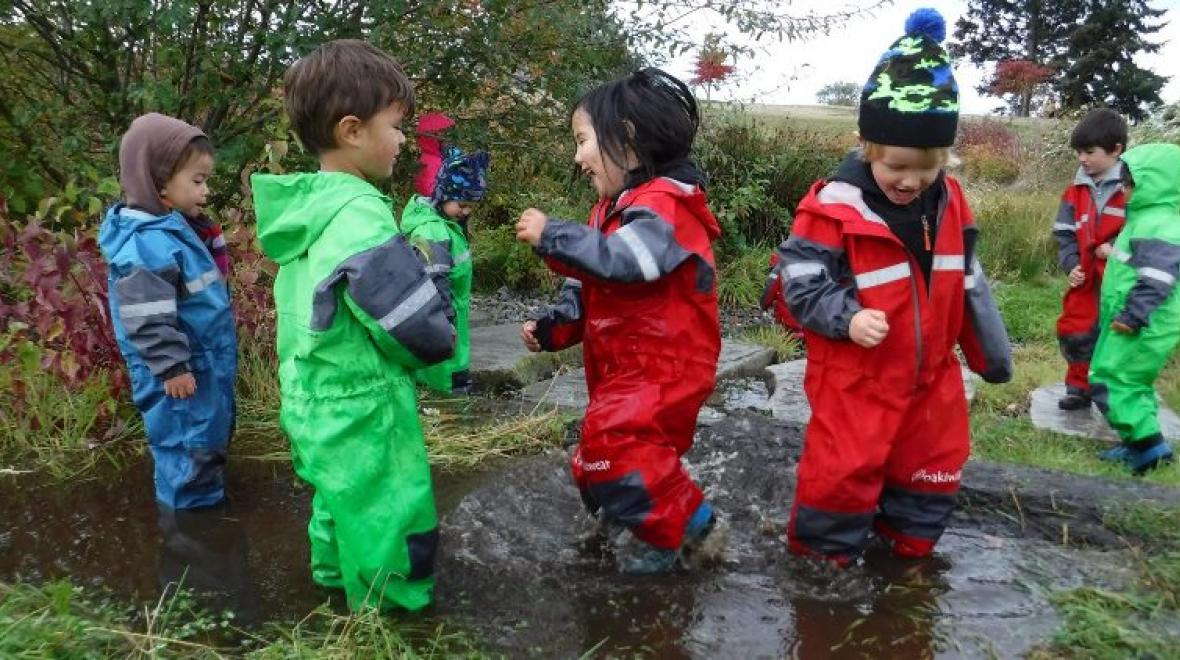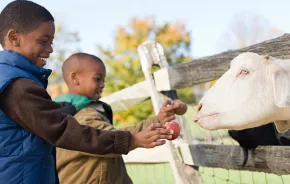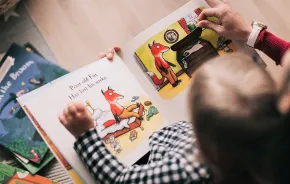
Photo:
Courtesy Tiny Trees
Editor's note: We know our readers are committed to getting outdoors with their kids, but when the rain and wet snow and hail pile on, it sure is hard to motivate. So we turned to Tiny Trees Preschool, whose kids are out all day every day, for their strategies. This article, about what their educators learned during last year's epic La Niña winter, originally appeared on the website of Tiny Trees. It's reprinted with permission.
Tiny Trees opened six outdoor preschools in 2017, the wettest winter since record keeping began in 1890. Here’s what we learned.
Dress like an Alaskan fisherman
We tried many different rain suits for our preschoolers last year and our favorite was Grundens – designed for use by fishermen in the Arctic and Alaska. The thick rubbery material is impregnable – that means no water gets in or out. Combine a fisherman’s (fisher-person’s?) suit with long underwear and insulating layers and your child is set for a wet and wild winter.
Children don’t care
One parent shared a story about her child coming home after a very wet day: Mom: “What did you think about the weather?” Child: “What weather?” From a child’s perspective rain brings joy — big puddles to jump in, frogs to catch, and mud to get messy with.
Bring a change of clothes
One of the challenges of always living in the present is our children would be fearless when it came to water. Children laid down in puddles. Walked into ponds. Rolled in the mud. A few hours later that change of clothes came in handy.
Hot drinks and hot water makes a world of difference
We introduced camp stoves in the fall at all our forest schools. We used our camp stoves to make hot cocoa and tea, for oatmeal and hot foods during snack time, and to make lots of hot water. One snowy day tip: Fill an old Nalgene water bottle with hot water and put it in your rain suit.
Celebrate the awesomeness!
From sledding and snow-fort building, to spontaneous mud slides, every day last winter brought a new opportunity for awesome adventures. It was especially awesome when we could read a book about nature and then go searching for that book in the world around us (think "The Very Hungry Caterpillar" followed by finding leaves and plants that caterpillars have munched on). Want your book to last more than a couple winter days? Laminate.
It’s the transition days that are hard
It’s that first day when the weather changes from 50-degree temps and raining to 20 degrees and snowing that families and children need the most support. Last year, La Niña brought sudden and savage transition days (think early December). Our lesson was to watch the weather ahead of time and prepare families well in advance with tips over text message and lots of coaching from teachers.
Puddles never get old
After seven months of the most epic puddles, our students are still seeing who can make the biggest splash.
There’s a lot of hidden sunshine
When you are outside every day you realize how many beautiful, sunny moments break up our rainy days.
Wool and synthetic layers are essential
Cotton clothes like jeans, sweatshirts and T-shirts always got soggy quickly and children got cold. Look on the tag at what material it is made of: wool, nylon, or polyester are going to keep your child warm. If it’s cotton save it for the summer.
Keep it cheap
Kids are so rough and tumble with their clothes that we discouraged parents from buying new and name brand. Look at Goodwill, Costco, or consignment stores for cheap deals. Don’t think about fashion, think about warmth and cost.
Mittens matter
Our big surprise was that children don’t know how to use the thumb hole. When most kids put on mittens for the first time they used them like flippers, and would take them off after the flippers failed. Once they learned how to use the thumb hole they were much more excited to keep them on.
Hand warmers are handy
They are so soothing to stick in a boot or a glove. We ended up using so many hand warmers we moved towards rechargeable ones. They last longer and can be passed around.











